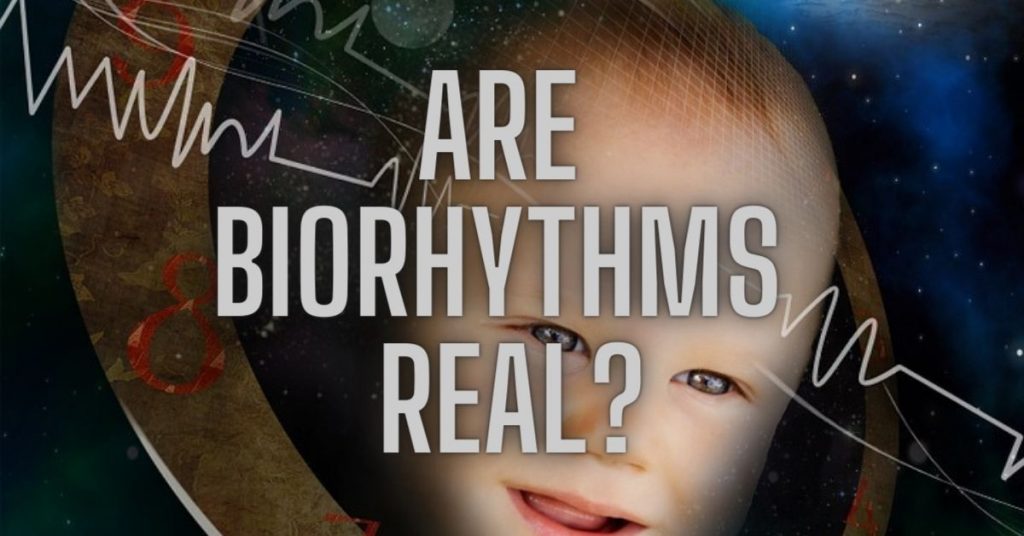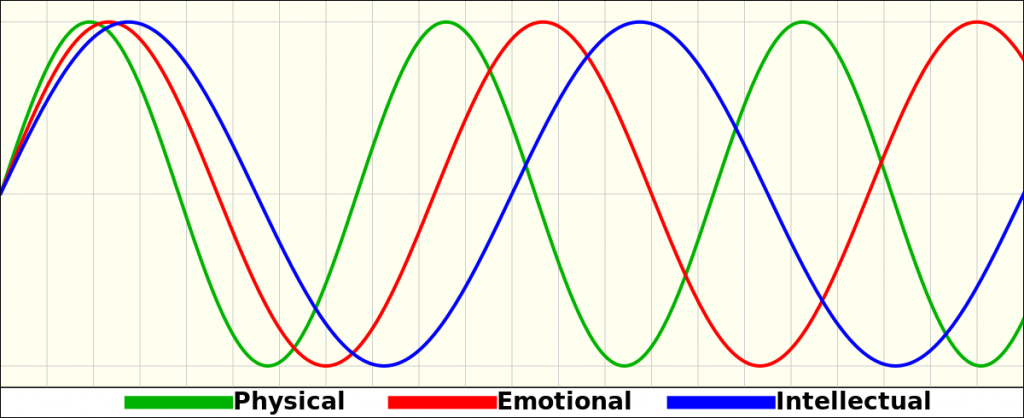Are Biorhythms Real?

Most individuals have heard of biorhythms sooner or later of their lives and wonder whether biorhythms are real or not. However many simply brush them off as fiction.
They think that it is just like a horoscope, an enjoyable diversion with little or no foundation in truth.
They are shocked to learn simply how much analysis has gone into the idea of biorhythms, and that they’ve been used successfully to optimize efficiency for a few years.
Here is just a little background info on the invention and analysis of biorhythms.
Biorhythm: What is it? (Are Biorhythms Real?)
Table of Contents
Biorhythm theory proposes that rhythmic cycles influence our daily lives. There are three major cycles traditionally identified by supporters of biorhythm theory.
A 23-day cycle occurs physically, a 28-day cycle occurs emotionally, and a 33-day cycle occurs intellectually. The theory, however, has since been expanded to include additional cycles.
Historical Background of Biorhythm (Are Biorhythms Real?)
Wilhelm Fliess developed the Biorhythm theory during the second half of the 19th century. The idea later gained popularity in the U.S. during the 1970s.
The traditional biorhythm theory contends that humans’ mental, physical, and emotional activity is affected by the three rhythmic biological cycles.
These cycles move steadily in cycles from birth until death, according to the biorhythm theory. As a result of biorhythm theory, one can calculate an individual’s ability in each of these three areas.
In addition to being a doctor in Berlin, Wilhelm Fliess was a patient of Sigmund Freud. The 23-day cycle and 28-day cycle were the first rhythmic cycles to be introduced by him in the late 19th century.
A certain pattern and regularity can be observed at every 23-day and 28-day interval, according to Wilhelm Fliess (these patterns and regularities include births and deaths).
Initially, Fliess referred to the 23-day rhythmic cycle as “male” and the 28-day rhythmic cycle as “female” (because the 28-day period matched the period between a woman’s menstrual cycle).
An Austrian psychologist named Hermann Swoboda made more contributions to the theory. Alfred Teltscher, an engineering professor at the University of Innsbruck, suggested that these rhythmic patterns affected the performance of students. Alfred Teltscher said that the 33-day cycle affects the brain’s ability to absorb information and alertness.
The popularity of biorhythm charts grew in the second half of the twentieth century. An organization called Biorhythm Computers Inc. theorized it could predict various events, including those in sports, by selling biorhythm charts and biorhythm calculators.
When you inputted your date of birth, many arcades and amusement areas in the U.S. had machines that charted your biorhythm cycle.
Understanding Biorhythms (Are Biorhythms Real?)
You don’t have to be an expert to read a biorhythm chart. The biorhythm calculators available online are quite affordable, and there are a variety of options.
The day, month, and year of your birth must be entered in the appropriate boxes in order to perform the calculation. Alternatively, you can also enter the time of your birth (so long as you recall it). You may also be required to enter the time zone of the country where you were born when using some calculators.
That is all there is to it; clicking the “calculate” button will lead you to your biorhythm chart. Your biorhythm cycles will be represented as a line chart by most of the calculators. Your biorhythms for the present day, week, etc. will be displayed in these line charts.
There will be three different colored lines on a basic chart (so that you can differentiate between the different cycles). Most of the time, the red line will reflect your physical cycle, the green line will symbolize your emotional cycle, and the blue line will indicate your mental cycle. On your chart, try to locate the midpoint. This midpoint should be above your cycle line. A cycle line above this midpoint indicates a positive trend, whereas a cycle line below it indicates a negative trend.
Observe the critical days in your chart as well. It’s imperative that you take special care of your emotional and physical well-being during the current time of stress in your life because it might cause you to feel emotionally depleted and physically fatigued.
As one example, graphical curves depicting biorhythm readings have a horizontal line representing time (most commonly days) and a vertical line representing the reading at that point in time. In most cases, readings are expressed as percentages and these percentages can indicate positive, negative, or zero readings.
Readings of +100% and -100% are considered maximums and minimums, respectively, whereas readings of zero are deemed middles.
You can find your physical biorhythm by looking at the graph of your biorhythm, located on the day of the week, and you can read the vertical indicator (which is between 100% and -100%).
You should also do this for your intellectual and emotional biorhythms. Your task will be quite simple for you, I’m sure.
Now that you have analyzed your biorhythms and identified your current state, what should you do?
You are free to respond however you wish. Many people refuse to leave their houses when all of their biorhythms are showing -100%. Others, however, view these negative indicators as merely warning signs and dedicate more time to self-care during that period.
Moreover, keep in mind that biorhythm cycles cannot be used to predict particular life events. It’s possible to get sick even if your physical cycle is 100%, but it’s thought that your condition would be more severe if it occurred on a day when you are in the negative numbers.
The day on which your line crosses zero marks is another noteworthy event. During these transitions, it is interpreted that things may get a bit chaotic.
New and traditional biorhythm cycles (Are Biorhythms Real?)
Most likely, you wonder what each cycle regulates.
Physical cycle may influence sex drive, strength, metabolism, stamina, hand-eye coordination, and initiative.
We believe the emotional cycle controls our mood, creativity, and affection.
Finally, the cognitive cycle influences reasoning, memory, concentration, ability to deduce, sense of direction, decision-making, and alertness.
You can also monitor other biorhythms besides your physical, emotional, and intellectual biorhythms.
Passion, wisdom, mastery, and other biorhythms are also included. Let’s see what they monitor.
If you use the passion cycle, for instance, you can track how motivated you are to make decisions and how driven you are to pursue something challenging. Monitor your passion cycle to determine the best time to begin working on a challenging project.
In addition, there is the mastery cycle. You can use it to track your progress toward achieving your goals and performing tasks. You may also be able to decide which days will be the best for learning new skills by monitoring this cycle.
Using the wisdom cycle, you may learn when making important decisions is the most appropriate time. The cycle also might point to the time when your senses are on high alert, and you have heightened awareness of what is happening around you.
It is also a good idea to monitor intuition, since it might act as a sixth sense of sorts. You might want to keep an eye on this cycle if you want to know when to trust your gut. Your relaxation and harmony cycles influence your intuition cycle. Continue reading to learn more about them.
You can use the harmony cycle to evaluate your surroundings and feelings about yourself. One of the most pleasing things you can do is interact with others, reflect on your life path, or attend an interview.
As well as monitoring your attitude and inner stability, the relaxation cycle monitors your relaxation level. Keeping track of this cycle will help you determine which day is best to handle stressful situations.
The teamwork cycle shows you how well you perform in a team and may also show you the best time to start working with colleagues on a new project.
Two individuals’ primary cycles are summed up in the balance cycle and compared. You could use it to determine the level of daily compatibility between you and your partner.
Lastly, there is also their romantic cycle. Keeping an eye on this cycle can help you figure out when is the best time to go out on a date, spend time together romantically, or engage in romantic activities in general.
For more information about your biorhythm, please visit the following link: The Biorhythm.
The Three Cycles of Biorhythms (Are Biorhythms Real?)
Dr. Lexford Hersey, who was from the University of Pennsylvania, had confirmed that all the three of these biorhythm cycles existed. His experiment was based on the effectivity and accident prevention experiments that involved staff members from the railway department.

Also, Dr. Hans Swing on the Swiss National Institute of Technology did a examine of 700 accidents and 300 deaths in 1939. He decided that 401 of the accidents and 197 of the deaths have been associated to unfavorable biorhythms. That works out to 57% and 66%, respectively.
Other research embody one involving the sanitation division of the town of Hanover. It was decided that 83% of the rubbish and watering truck accidents within the metropolis occurred on warning days.
Yet one other examine, carried out by Dr. Reinhold Bochow in Berlin, concerned 499 agricultural accidents. He discovered that 62% of the accidents studied have been associated to biorhythms.
In addition to the bodily, emotional and mental cycles, a number of different biorhythm cycles have been proposed and even charted.
But these three are the only ones which have been subjected to intense scientific examine, and due to this fact the one ones which were confirmed legitimate.
That’s to not say that not one of the others have benefit, simply that they haven’t been studied sufficiently.
There has been a lot of debate over the years in regard to the validity of biorhythms as a whole.
While most scientists and medical professionals agree that man’s bodily and emotional states are all the time fluctuating, not all agree that they fluctuate in accordance with common cycles that start at delivery.
But as you possibly can see, there is numerous research that supports the ideas of biorhythms.
Conclusion (Are Biorhythms Real?)
Our lives are influenced by bodily, emotional, and psychological cycles, as demonstrated by biorhythm charts.
By tracking the highs and lows of those cycles and displaying them appropriately, biorhythm charts and readings are said to better their quality of life.
It is possible to estimate (calculate) your compatibility with another person to gauge how you both will react to bodily, emotional, and psychological experience together.
>>> Read my review on The Biorhythm – Using this program, anyone can unlock the ability to predict their future
